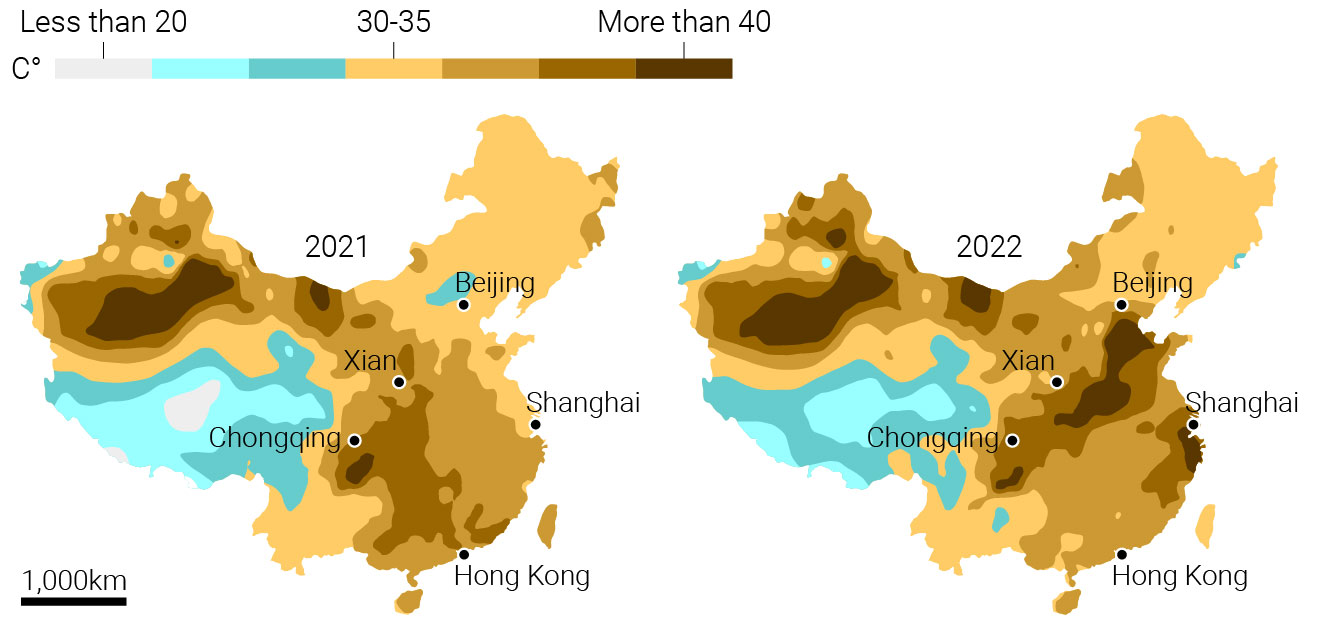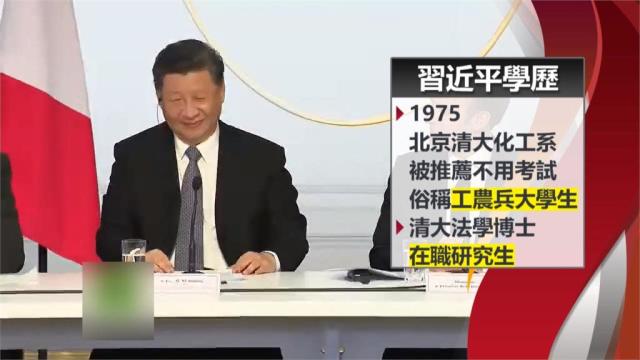
In the summer of 2022, China was hit by its most severe heatwave in six decades, exacerbating a drought that has impacted food and factory production, power supplies and transport in a vast area of the country. The Yangtze River Basin, which stretches from coastal Shanghai to Sichuan province in China’s southwest and includes Asia’s longest river, was considered the worst-affected area, with hundreds of millions of people impacted. Experts say the heatwave could be among the worst recorded in global history.
Scorching temperatures
For more than 70 days straight, a brutal heatwave ravaged much of China, with sustained temperatures of more than 40 degrees Celsius (104 Fahrenheit). It affected more than 900 million people in at least 17 provinces, from southwestern Sichuan to coastal Jiangsu and Zhejiang provinces in the east.
 Maximum temperatures in July
Maximum temperatures in JulySeverity of China’s drought
The map below shows the intensity of the drought, which has affected about half of China’s landmass, mostly in the country’s south. The drought is so severe that sections of the Yangtze River, China’s biggest river, reached their lowest level since at least 1865.
 |
Drought level (as of August 29, 2022)
The Yangtze’s low water level has been caused by low rainfall in the river basin, reduced water flowing in from its upper reaches and hotter temperatures speeding up evaporation.
River flow (4-month forecast from August 2022)
 Affected areas
Affected areas Since July, provinces and cities in southern China, including Anhui, Jiangxi, Hubei, Hunan, Chongqing and Sichuan, were affected by drought. Low water levels in the Yangtze River increased pressure on hydroelectric power plants, affecting water supply and electricity production for millions of people and many companies, forcing the temporary closure of factories in some provinces.
Since July, provinces and cities in southern China, including Anhui, Jiangxi, Hubei, Hunan, Chongqing and Sichuan, were affected by drought. Low water levels in the Yangtze River increased pressure on hydroelectric power plants, affecting water supply and electricity production for millions of people and many companies, forcing the temporary closure of factories in some provinces.Water levels measured at the major hydrologic stations
Drying up

 China’s two largest freshwater lakes – Poyang and Dongting, which connect to the Yangtze River – saw their lowest levels since records began in 1951. The biggest, Poyang Lake in eastern China, was at 12 metres on August 6, 2022. That meant it had entered the dry season about 100 days earlier than the average in previous years.
China’s two largest freshwater lakes – Poyang and Dongting, which connect to the Yangtze River – saw their lowest levels since records began in 1951. The biggest, Poyang Lake in eastern China, was at 12 metres on August 6, 2022. That meant it had entered the dry season about 100 days earlier than the average in previous years.Sichuan: China's biggest hydropower producer
 Sichuan province normally generates almost 30 per cent of China’s hydroelectric power. But the 2022 heatwave saw historically low water levels and, as a result, a massive drop in electricity production.
Sichuan province normally generates almost 30 per cent of China’s hydroelectric power. But the 2022 heatwave saw historically low water levels and, as a result, a massive drop in electricity production.







 该报告说,过去多年以强劲经济成长见长的中国,在2022年上半年的经济成长已经显著放缓,甚至有经济失速的风险。中国经济面临失速风险,最大的影响因素是疫情冲击。面对高传染率、低重症率、极低病死率的Omicron病毒,中国给自己设定了一个极高的抗疫标准。
该报告说,过去多年以强劲经济成长见长的中国,在2022年上半年的经济成长已经显著放缓,甚至有经济失速的风险。中国经济面临失速风险,最大的影响因素是疫情冲击。面对高传染率、低重症率、极低病死率的Omicron病毒,中国给自己设定了一个极高的抗疫标准。


 据“情报在线”称,中国倾向对台湾行动采速战速决、不寻求外援的策略。而且习近平不希望让人以为,俄国对台海的政治战略协助将能换来中国对俄罗斯在乌克兰前线战事的支援。
据“情报在线”称,中国倾向对台湾行动采速战速决、不寻求外援的策略。而且习近平不希望让人以为,俄国对台海的政治战略协助将能换来中国对俄罗斯在乌克兰前线战事的支援。

 First, as is widely known, Europe and Germany are facing a very cold
winter as Russian energy exports decline. It’s possible that the German
weapons “deficit” is a concession to Russia, but it’s highly unlikely:
Berlin could not do this without it being widely known in NATO, where
member states’ weapons capacities are known and production is tracked.
This would get out to the Ukrainians, Poles and Americans. We would have
heard about this by now.
First, as is widely known, Europe and Germany are facing a very cold
winter as Russian energy exports decline. It’s possible that the German
weapons “deficit” is a concession to Russia, but it’s highly unlikely:
Berlin could not do this without it being widely known in NATO, where
member states’ weapons capacities are known and production is tracked.
This would get out to the Ukrainians, Poles and Americans. We would have
heard about this by now.




 在出访申请提交期限即将到期之际,德国联邦议院人权委员会正式提交了出访台湾和日本的申请。人权委员会主席自民党籍政治家阿尔特( Renata Alt)周末对《法兰克福汇报》表示:"中国方面正在不断地秀肌肉,有鉴于此,我们必须展示民主政体之间的团结精神。我们出访的目标是,遏制专制趋势,强化民主和人权。在制度性竞争日益激烈的今天,这样做尤为必要。"
在出访申请提交期限即将到期之际,德国联邦议院人权委员会正式提交了出访台湾和日本的申请。人权委员会主席自民党籍政治家阿尔特( Renata Alt)周末对《法兰克福汇报》表示:"中国方面正在不断地秀肌肉,有鉴于此,我们必须展示民主政体之间的团结精神。我们出访的目标是,遏制专制趋势,强化民主和人权。在制度性竞争日益激烈的今天,这样做尤为必要。" 访台计划预计在十月下旬实施。上一届立法期内,就曾制定过相应的访台计划,但受疫情影响,出访计划被迫延迟。也正因为如此,来自人权委员会的消息一再强调,访台计划同此前美国众议院议长佩罗西的访台行动毫无关联。佩罗西今年八月初访问台湾之后,中国方面曾在台海周边地区展开大规模军事演习。
访台计划预计在十月下旬实施。上一届立法期内,就曾制定过相应的访台计划,但受疫情影响,出访计划被迫延迟。也正因为如此,来自人权委员会的消息一再强调,访台计划同此前美国众议院议长佩罗西的访台行动毫无关联。佩罗西今年八月初访问台湾之后,中国方面曾在台海周边地区展开大规模军事演习。
 文章写道,近段时间,两则有关中国的消息得到斯里兰卡各界广泛关注,“一是美国国会众议长佩洛西窜访中国台湾地区,中方第一时间作出坚决反制”,斯里兰卡多个政党、团体也公开发声、“仗义执言”;二是本月中旬,中斯两国“共同抵制了来自第三方毫无理由的蛮横干预”,中方科考船“远望5号”按照斯方最新批准,顺利停靠汉班托塔港完成补给。
文章写道,近段时间,两则有关中国的消息得到斯里兰卡各界广泛关注,“一是美国国会众议长佩洛西窜访中国台湾地区,中方第一时间作出坚决反制”,斯里兰卡多个政党、团体也公开发声、“仗义执言”;二是本月中旬,中斯两国“共同抵制了来自第三方毫无理由的蛮横干预”,中方科考船“远望5号”按照斯方最新批准,顺利停靠汉班托塔港完成补给。 对此,印度驻斯里兰卡高级专员公署周日(28日)在推特发表了一系列声明,回应戚振宏的发言。推文写道:“我们注意到中国大使的言论。他对基本外交礼仪的违反可能是个人特征,也可能反映了更大的国家态度。”
对此,印度驻斯里兰卡高级专员公署周日(28日)在推特发表了一系列声明,回应戚振宏的发言。推文写道:“我们注意到中国大使的言论。他对基本外交礼仪的违反可能是个人特征,也可能反映了更大的国家态度。”